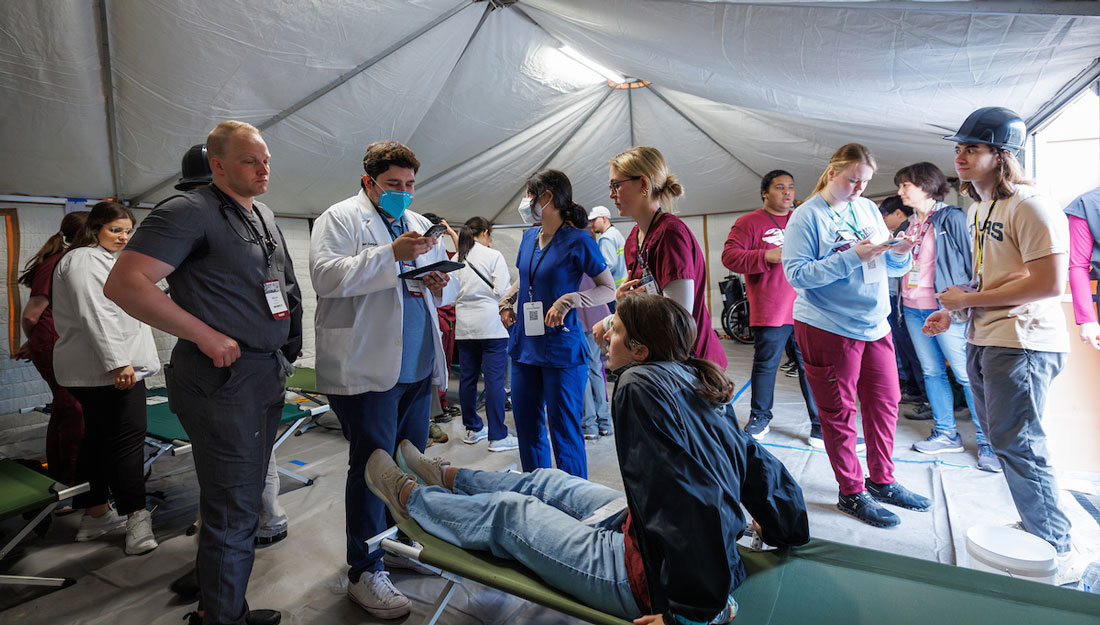- Mary Leigh Meyer
- Dentistry, Medicine, Nursing, Pharmacy, Public Health, Show on VR homepage
Stress in the health professions
Reducing health profession students’ stress now improves their delivery of quality care in the future

Students and faculty walk around their building
A growing concern in the health professions is the rising levels of stress in the workplace. In general, health care professionals are more prone to stress and professional burn-out than other occupations. These elevated stress levels are most likely because their actions can have a serious impact on human lives—the very reason providers and their skills are so vital. That’s why the Texas A&M University Health Science Center is teaching students how to properly manage their stresses now, so they are prepared to deliver the best care in the future.
Texas A&M College of Dentistry
One of the biggest stresses new dentists face comes from the transition from school to practice.
“An internship or residency is not necessary to practice dentistry,” said Jayne Reuben, PhD, instructional associate professor of biomedical sciences at the Texas A&M College of Dentistry, director of instructional effectiveness. “If the students pass their boards, then they need to be ready to treat patients immediately.”
To mitigate some of the transitional stress, the College of Dentistry offers a mentorship program to connect students with the practicing dental community. These students gain counsel and guidance about some of the concerns involved with beginning a dental career.
This year marks the inaugural year for the Wellness Task Force. A collegewide initiative, the Wellness Task Force is comprised of faculty, staff and student representatives. They plan to engage their students outside of the classroom by hosting wellness and healthy eating activities. “With the Wellness Task Force, we not only want to help our students through the stressful trials and tribulations of school,” Reuben said. “But we also want to set them up for success once they leave school and start practicing.”
Texas A&M College of Nursing
“According to national studies, nursing students reported that overwhelming stress and anxiety affected their academics more than non-nursing students,” said Susan McKee, MSN, MEd, clinical assistant professor at the Texas A&M College of Nursing. “These stress levels not only impact their studies, but they will also impact how prepared they are to practice.”
Led by McKee, the College of Nursing offers an optional, 16-hour mindfulness-based program for students to reduce stress and anxiety. The course, which is two hours a week for eight weeks, teaches students to be present in the moment. In other words, instead of thinking about the past or future, the course teaches them to focus on things right now.
“We want them to be academically prepared, but also personally prepared to be successful in the workforce,” said McKee. Studies of working nurses have found understaffing, exposure to infectious diseases, difficult or seriously ill patients and sleep deprivation to be some of the most common stressors. “The stress they experience in the workforce may influence their ability to provide patient care, so we are really trying to give them all the tools they need to give the best care.”
Texas A&M College of Medicine
According to a recent survey of more than 15,000 doctors across multiple specialties, about 42 percent of physicians report feeling burned out. About 48 percent of physicians in critical care and neurology, 47 percent of physicians family medicine and 46 percent of physicians obstetrics and gynecology reported feelings of burnout.
That’s why the College of Medicine is trying to reach students early.
“Starting in medical school, students develop strategies to manage their stress. Some of the strategies work during residency, but some fail,” said Meredith Williamson, PhD, licensed psychologist and clinical assistant professor in Family Medicine Residency Program the Texas A&M College of Medicine.
The College of Medicine has many working components and each does something different to manage the stress of their students. For example, the college’s Family Medicine Residency Program, one of the types of medicine most at risk for physician burn-out, has an entire wellness program, including a wellness committee of residents.
Williamson conducts biannual objective assessments of each resident’s wellbeing, and the wellness committee suggests improvements for the program. For example, one year, they saw a need for updated furniture at the hospital, so the program replaced furniture. The new furniture allowed the residents to be more comfortable during their time away from patients.
“The reality is that students will be stressed during medical school and residency and beyond. They cannot avoid it, but they can learn effective techniques to succeed in the face of stress,” Williamson said.
Texas A&M Irma Lerma Rangel College of Pharmacy
Research on pharmacist stress and burnout is limited within the United States. However, one study associated inadequate time for teaching, inadequate administration time, difficult colleagues and underappreciated contributions with burnout.
Similarly, students at the Texas A&M Irma Lerma Rangel College of Pharmacy often find the root of their stresses come from not only academic influences but personal and social influences as well. “We look at our students holistically,” said Amanda Galvan, LPC, director of student success at the Rangel College of Pharmacy. “In order for them to thrive academically and succeed in the workforce, we need to give them the tools and resources they need to take care of any other issues that might interfere.”
The college offers emotional wellness workshops to all incoming students to encourage open discussion about mental wellness, as well as individual counseling sessions. “We want to destigmatize the conversation around mental wellness,” Galvan said. “There are strategies that students can practice to enhance emotional health before stress and burnout happen.”
School of Public Health
“Most public health practitioners experience chronic, long-term stress rather than acute, short-term stress like the other health professions,” said Selina Stasi, DrPH, MPH, instructional assistant professor at the Texas A&M School of Public Health. “Public health practitioners’ problems often take longer to solve than other health professions, so they often carry that burden overtime.”
One of the biggest initiatives by the School of Public Health, World Fit Walk, faculty, staff and students walk as a school around the building multiple times throughout the year. The walking program brings leaders from the community like military members or former Olympians to speak about the importance of wellness. The program has been so successful with the school that now entire departments and labs walk together on their own accord, in addition to participating in the official walking program.
“These activities build the culture that we want to be true to what we are preaching to the community,” Stasi said. “We hope our students can take away the importance of wellness and teach their communities for years to come.”
Media contact: media@tamu.edu


